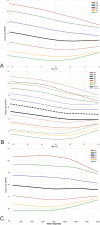Real-world heart rate norms in the Health eHeart study
- PMID: 31304404
- PMCID: PMC6592896
- DOI: 10.1038/s41746-019-0134-9
Real-world heart rate norms in the Health eHeart study
Abstract
Emerging technology allows patients to measure and record their heart rate (HR) remotely by photoplethysmography (PPG) using smart devices like smartphones. However, the validity and expected distribution of such measurements are unclear, making it difficult for physicians to help patients interpret real-world, remote and on-demand HR measurements. Our goal was to validate HR-PPG, measured using a smartphone app, against HR-electrocardiogram (ECG) measurements and describe out-of-clinic, real-world, HR-PPG values according to age, demographics, body mass index, physical activity level, and disease. To validate the measurements, we obtained simultaneous HR-PPG and HR-ECG in 50 consecutive patients at our cardiology clinic. We then used data from participants enrolled in the Health eHeart cohort between 1 April 2014 and 30 April 2018 to derive real-world norms of HR-PPG according to demographics and medical conditions. HR-PPG and HR-ECG were highly correlated (Intraclass correlation = 0.90). A total of 66,788 Health eHeart Study participants contributed 3,144,332 HR-PPG measurements. The mean real-world HR was 79.1 bpm ± 14.5. The 95th percentile of real-world HR was ≤110 in individuals aged 18-45, ≤100 in those aged 45-60 and ≤95 bpm in individuals older than 60 years old. In multivariable linear regression, the number of medical conditions, female gender, increasing body mass index, and being Hispanic was associated with an increased HR, whereas increasing age was associated with a reduced HR. Our study provides the largest real-world norms for remotely obtained, real-world HR according to various strata and they may help physicians interpret and engage with patients presenting such data.
Keywords: Epidemiology; Predictive markers.
Conflict of interest statement
Competing interestsG.M. has received research funding from Medtronic and Cardiogram Inc, is a consultant for Lifewatch and InCarda, and holds equity in InCarda. P.K. is an employee of Azumio. There are no disclosures for the remaining authors. Azumio provided no financial support for this study and only provided access to the heart rate data. Data analysis and interpretation was performed independently from Azumio.
Figures
Similar articles
-
Resting and Postexercise Heart Rate Detection From Fingertip and Facial Photoplethysmography Using a Smartphone Camera: A Validation Study.JMIR Mhealth Uhealth. 2017 Mar 13;5(3):e33. doi: 10.2196/mhealth.7275. JMIR Mhealth Uhealth. 2017. PMID: 28288955 Free PMC article.
-
Heart rate variability (HRV) in deep breathing tests and 5-min short-term recordings: agreement of ear photoplethysmography with ECG measurements, in 343 subjects.Eur J Appl Physiol. 2016 Aug;116(8):1527-35. doi: 10.1007/s00421-016-3401-3. Epub 2016 Jun 8. Eur J Appl Physiol. 2016. PMID: 27278521
-
Validation of Heart Rate Extracted From Wrist-Based Photoplethysmography in the Perioperative Setting: Prospective Observational Study.JMIR Cardio. 2021 Nov 4;5(2):e27765. doi: 10.2196/27765. JMIR Cardio. 2021. PMID: 34734834 Free PMC article.
-
Detection of heart rate using smartphone gyroscope data: a scoping review.Front Cardiovasc Med. 2023 Dec 18;10:1329290. doi: 10.3389/fcvm.2023.1329290. eCollection 2023. Front Cardiovasc Med. 2023. PMID: 38164464 Free PMC article.
-
Is Heart Rate a Confounding Factor for Photoplethysmography Markers? A Systematic Review.Int J Environ Res Public Health. 2020 Apr 10;17(7):2591. doi: 10.3390/ijerph17072591. Int J Environ Res Public Health. 2020. PMID: 32290168 Free PMC article.
Cited by
-
Experience of using a smartphone WeChat applet for dental anxiety assessment and preoperative evaluation: A nationwide multicenter study.Front Public Health. 2022 Jul 18;10:900899. doi: 10.3389/fpubh.2022.900899. eCollection 2022. Front Public Health. 2022. PMID: 35923975 Free PMC article.
-
Wearable Cardiorespiratory Sensors for Aerospace Applications.Sensors (Basel). 2022 Jun 21;22(13):4673. doi: 10.3390/s22134673. Sensors (Basel). 2022. PMID: 35808167 Free PMC article.
-
Human induced pluripotent stem cell (iPSC)-derived cardiomyocytes as an in vitro model in toxicology: strengths and weaknesses for hazard identification and risk characterization.Expert Opin Drug Metab Toxicol. 2021 Aug;17(8):887-902. doi: 10.1080/17425255.2021.1894122. Epub 2021 Mar 8. Expert Opin Drug Metab Toxicol. 2021. PMID: 33612039 Free PMC article.
-
Feasibility of Radar Vital Sign Monitoring Using Multiple Range Bin Selection.Sensors (Basel). 2025 Apr 20;25(8):2596. doi: 10.3390/s25082596. Sensors (Basel). 2025. PMID: 40285284 Free PMC article.
-
Wearable Sensors as a Preoperative Assessment Tool: A Review.Sensors (Basel). 2024 Jan 12;24(2):482. doi: 10.3390/s24020482. Sensors (Basel). 2024. PMID: 38257579 Free PMC article. Review.
References
Grants and funding
LinkOut - more resources
Full Text Sources
Miscellaneous


